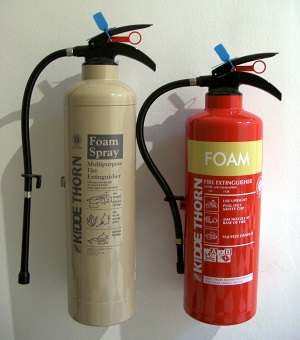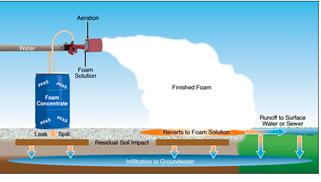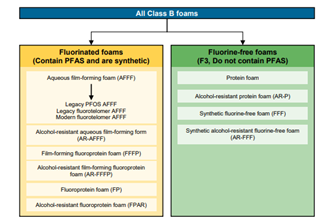Firefighting Foam
Understanding and mitigating the potential risks associated with environmental releases of firefighting foam containing PFAS.
PFAS have been used for decades in fire protection equipment and types of Class B firefighting foam, the most common of which is known as aqueous film forming foam (AFFF).
Firefighting foam containing PFAS has been and continues to be stored and used in New Hampshire for fire suppression, fire training and flammable vapor suppression at the following types of locations:
- Military installations.
- Airports.
- Petroleum bulk storage facilities.
- Emergency Planning and Community Right to Know Act (EPCRA) Tier II Facilities.
- Local fire departments.
Many local fire departments in New Hampshire communities currently maintain firefighting foam containing PFAS in their inventories. NHDES recognizes that firefighting foam containing PFAS is an important resource for emergency responders that will continue to be necessary to perform certain duties safely and effectively until a suitable replacement is found.
A new state law that went into effect in September 2019 prohibits firefighting foams containing PFAS for use in testing or training on or after January 1, 2020, and includes requirements designed to reduce environmental contamination and reduce the risk of public health impacts for firefighters and New Hampshire citizens. To better understand New Hampshire law regarding firefighting foam containing PFAS, refer to NHDES fact sheet REM-39: Certain Chemicals Prohibited in Firefighting Foam.
The use of this type of foam constitutes an urgent public health challenge where action and associated changes are needed to limit future contamination and to reduce exposure to firefighters and New Hampshire residents. Refer to the FAQs for important information to support decision-making about firefighting using AFFF and its alternatives.
 New Hampshire’s 2020 Foam Survey Report
New Hampshire’s 2020 Foam Survey Report
RSA 154:8-b, effective September 3, 2019, among other things, required NHDES to survey municipalities throughout the state on the quantitative stock of legacy Class B firefighting foams containing PFAS. NHDES in partnership with the State Fire Marshal’s Office issued a Legacy PFAS Firefighting Foam (AFFF) Self Inventory Survey Letter to New Hampshire municipalities on July 31, 2020. A report was prepared by NHDES dated December 1, 2020, to summarize the survey findings and provide recommendations and a framework for an AFFF takeback program.
 AFFF Disposal Options
AFFF Disposal Options
Disposal of AFFF concentrate represents a significant challenge for any owner of firefighting foam concentrates. The disposal of AFFF concentrates through standard disposal options may carry risks. Practitioners should be aware of possible disposal options, best management practices and disposal hierarchy, as explained by EPA in its interim PFAS destruction and disposal guidance, published in December 2020. One option for addressing disposal concerns related to environmental releases is to store AFFF in warehouse storage to provide time for completion of studies for destruction, disposal or stabilization of the AFFF.
 Guidance for Use of Class B Firefighting Foams
Guidance for Use of Class B Firefighting Foams
The Fire Fighting Foam Coalition has published a "Best Practice Guidance for Use of Class B Firefighting Foams" that outline steps that should be taken to protect the environment when using fluorinated Class B foams. It includes guidance on proper foam selection, containing and eliminating foam discharge, and disposal of foam and firewater.
How does PFAS get into the environment from firefighting foam?
Some of the most significant levels of PFAS contamination in groundwater found in New Hampshire have been associated with firefighting foam discharges.
Firefighting foam containing PFAS can enter the environment in multiple ways including (but not limited to) through applications associated with emergencies (fire or hazardous materials releases); system discharge or false activation; firefighter training; and system testing.
Firefighting foam with PFAS can get into groundwater and contaminate wells and drinking water supplies, as well as expose firefighters and others to PFAS. The figure illustrates the use of firefighting foam and potentially affected media. Even a small amount of AFFF can result in significant impacts to drinking water. Because of this, the use of firefighting foams containing PFAS constitutes an urgent public health challenge, where action and associated changes are needed to limit future contamination and to reduce exposure to firefighters and New Hampshire residents.
What do all of these AFFF terms mean?
There are many terms used in the various resources available when it comes to firefighting foams. Some of these common terms are summarized below.
“AFFF” means aqueous film forming foams. When referring to AFFF, NHDES assumes all AFFF contains PFAS.
"Class B firefighting foam" means foam designed for flammable liquid fires.
“Fluorine-Free Foams” means foam that does not contain fluorinated compounds.
"Legacy foams" in New Hampshire law means firefighting foams manufactured prior to January 1, 2004, containing perfluorooctanesulfonic acid (PFOS) and/or perfluorooctanoic acid (PFOA) related long chain PFAS fluorinated compounds (C8).
“Legacy PFOS Foams” means foams that contain long-carbon-chain fluorinated compounds (C8), specifically PFOS and PFOA, manufactured prior to 2003 by 3M and sold under the brand name “Lightwater” (ITRC 2021).
“Modern fluorotelomer AFFF” means short-chain (C6) fluorotelomer-based fluorosurfactants. Short-chain (C6) PFAS do not contain or breakdown in the environment to PFOS and other long-chained PFAS but may still contain small quantities (parts per billion [ppb] levels) of PFOA and PFOA precursors as byproducts of the manufacturing process.
How do I tell if foam contains PFAS?
There are two major classes of firefighting foam:
- Class A Foam: Used to extinguish Class A materials, such as wood, paper, and brush (wildland), is widely used by many fire departments for structural firefighting using a foam-water solution or a compressed air foam system. Class A foams generally do not contain PFAS.
- Class B Foam: Used to extinguish Class B materials, which include gasoline, oil, and jet fuel. Although not usually categorized this way from a fire protection viewpoint, Class B foams can be divided into two categories (see figure below): fluorinated foams and fluorine-free foams. Fluorinated foams contain PFAS, and fluorine-free foams do not.
Of the fluorinated foams, aqueous film forming foams (AFFF) is the most widely available and commonly used. AFFF contains varying amounts and mixtures of PFAS. However, all fluorine containing foams are of concern to human health and the environment. The figure below highlights the two broad categories of Class B foams and their subcategories.
Even knowing this, it still may not be easy to tell if the foam you have contains PFAS. These chemicals are not currently required to be reported on safety data sheets (SDS). PFAS may not be listed under any active ingredients list, either. A good indicator that the foam contains PFAS is if the package or SDS mentions fluorosurfactant, fluoroprotein, C6 or the use of “fluoro.”
The best thing to do is to note the brand and manufacturer of the foam and contact the manufacturer in writing to see if PFAS are used in its production and ask for the SDS. Be sure to be clear that you mean the entire family of PFAS, not just the single compound PFOS, and be sure to review the SDS.
Are there PFAS-free foams?
Due to environmental concerns, the firefighting foams have changed composition in recent years. New foam formulations known as Fluorine Free Foams (FFFs, or “F3” foams) have been introduced and marketed as environmentally acceptable alternatives for firefighting foams containing PFAS (i.e. “legacy foams," “C6” or “C8” AFFF foams, etc). Organizations should determine whether a fluorine-free foam can achieve the required performance specifications for their specific target hazards as part of their pre-planning for replacement materials.
The Department of Defense (DoD) published a new Performance Specification (MIL-PRF-32725) titled “Fire extinguishing agent, fluorine-free foam (f3) liquid concentrate, for land-based, freshwater applications” on January 6, 2023. According to the publication, the specification was approved for use by all departments and agencies of the DoD.
While the State of New Hampshire does not endorse or recommend any specific product, fire departments and emergency responders can view information about PFAS-free solutions from the Interstate Chemicals Clearinghouse, including a list of known PFAS-free firefighting foams. Performance and testing of these solutions is ongoing.
Can I use AFFF in Emergency Response?
Decisions about when and how to use PFAS-containing foams should be made before, not during an emergency. The team should consider key factors such as these:
- The nature of the firefighting properties of the foam.
- The nature of the emergency.
- The risk to life, public safety and property.
- Potential environmental, public health and financial liabilities of using the foam.
Incident Commanders should use whatever firefighting foam they deem tactically necessary to meet the needs of the emergency. If that requires AFFF be used, the law requires that NHDES be contacted within 48 hours of its deployment.
Since even a small amount of AFFF can pose a risk to water supplies, an Incident Commander should consider whether other extinguishing agents (such as plain water, Class A foam, dry chemical) would effectively mitigate the emergency instead of using AFFF.
It is important to note that NH RSA 154:8-b holds fire departments immune from using remaining class B firefighting foam (to which PFAS has been added) under emergency conditions.
To report a discharge of AFFF, contact Amy Renzi of the Waste Management Division, Hazardous Waste Remediation Bureau at (603) 271-6542 or amy.t.renzi@des.nh.gov.
Can I train with AFFF or conduct equipment or system testing with AFFF?
NH RSA 154:8-b prohibits foams containing PFAS for use in testing or training on or after January 1, 2020, unless NHDES has evaluated the testing facility for containment, treatment and disposal measures to prevent uncontrolled release of AFFF to the environment.
NHDES recognizes there are requirements for inspection, testing and maintenance of fluorinated foam fire protection systems in New Hampshire. Regular testing needs to be completed to ensure the foam is properly proportioned, stored and ready to use in the event of a fire hazard.
If you would like NHDES to review a proposed program for equipment or systems testing using AFFF, please contact Amy Renzi of the Waste Management Division, Hazardous Waste Remediation Bureau at (603) 271-6542 or amy.t.renzi@des.nh.gov.
Your proposed testing program plan should provide sufficient information for NHDES to evaluate your program, including but not limited to, a description of the system/equipment, type of foam, testing methodology that includes anticipated testing flow rates and duration of flow, and estimated volumes of foam solution expected to be generated during the test(s). Your plan should also include a detailed description of how the generated foam solution will be contained, managed and disposed of. The plan must include steps to eliminate flushing, draining or otherwise discharging the foam onto the ground or into a storm drain or sanitary sewer.
If I need to use AFFF, do I need to report it?
NH RSA 154:8-b requires that when a discharge of firefighting foam containing PFAS (intentionally or accidentally) occurs, the municipality making the discharge notify NHDES within 48 hours of making the discharge. Importantly, NH RSA 154:8-b holds fire departments immune from using remaining firefighting foam containing PFAS under emergency conditions.
Information to convey to NHDES regarding AFFF discharged or released into the environment:
- Location, date and time of the use of AFFF.
- The estimated amount (gallons) and type of AFFF with specified concentration (i.e. 3%, 6%).
- Cause of use, or spill (i.e., emergency response, accidental discharge).
- Potentially impacted media (i.e., pavement, soil, surface water).
- The containment, treatment and disposal measures taken or used to prevent or minimize the discharge or release.
- The name of the person, unit of local government, fire department or state agency reporting the use of AFFF.
To report a discharge of firefighting foam containing PFAS, contact Amy Renzi of the Waste Management Division, Hazardous Waste Remediation Bureau at (603) 271-6542 or amy.t.renzi@des.nh.gov.
For emergency spill response support, contact NHDES’ Spill Response and Complaint Investigation Section (SRCIS). SRCIS responds to hundreds of spill calls each year. The on-call team of experienced responders cover the entire State of New Hampshire, who are available 24 hours a day, seven days a week.
Are there Best Management Practices for the use, storage and disposal of AFFF?
Best Management Practices (BMPs) should be established for the use of any firefighting foam to prevent possible releases to the environment that can lead to soil, groundwater, surface water and potentially drinking water contamination.
BMPs start with pre-planning and deciding which foam to keep in stock. The team should consider key factors such as these:
- Whether fluorine-free foams can meet site-specific performance requirements.
- Site-specific evaluation of likely fire hazards and potential risks for life, public safety and property.
- Potential environmental, human health and financial liabilities associated with AFFF releases.
- Site constraints, including existing equipment retrofit requirements, to adapt to alternate foams.
BMP guidance can be found in the following documents:
- The Fire Fighting Foam Coalition has developed BMPs for the use of Class B firefighting foam for the firefighting community.
- The Interstate Technology Regulatory Council (ITRC) has published a Fact Sheet about Class B firefighting foam, with more information in the associated guidance document. The fact sheet and guidance document describe approaches to identify, handle, store, capture, collect, manage and dispose of Class B firefighting foam.





